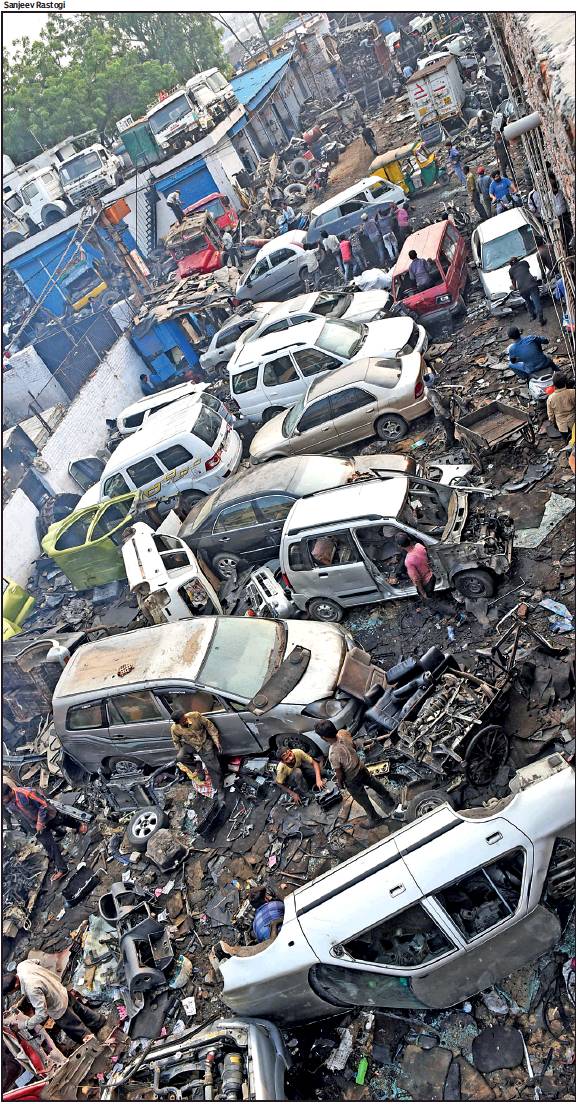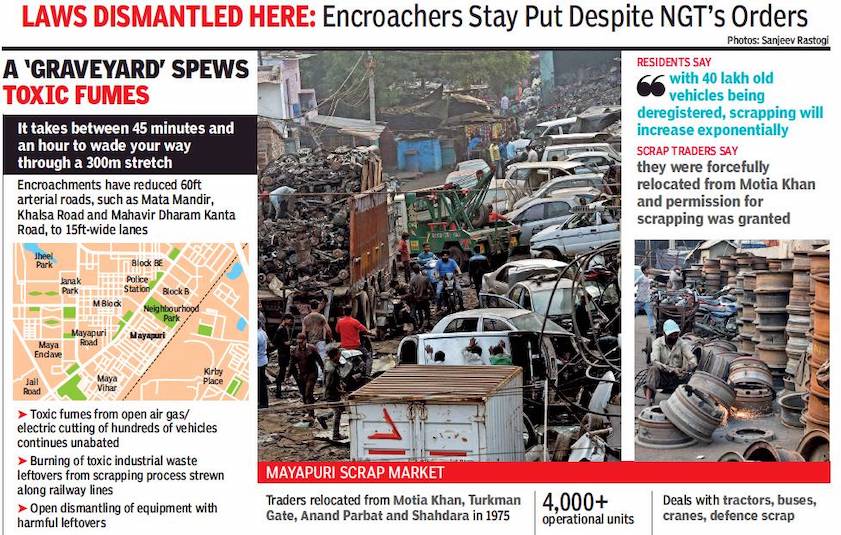Delhi: Mayapuri
This is a collection of articles archived for the excellence of their content. |
Scrapyard, illegal
Pollution, encroachments: as in 2018
Paras Singh, In factory setting, Mayapuri’s scraping through, November 19, 2018: The Times of India

From: Paras Singh, In factory setting, Mayapuri’s scraping through, November 19, 2018: The Times of India

From: Paras Singh, In factory setting, Mayapuri’s scraping through, November 19, 2018: The Times of India
There are two special task forces, one appointed by the Supreme Court to remove encroachments, the other by the National Green Tribunal to curb pollution causing activities, and yet Mayapuri Industrial Area continues to thrive on its illegal scrap economy.
Traversing 300 metres to get to Phase 2 of the industrial area on the main road takes at least 45 minutes because the 60-ft road has been narrowed to 15 ft by a congestion of unpermitted storage spaces and junk processers.
The situation is so discouraging that businesses located behind these impossible lanes are moving out. R K Gupta, general secretary of Mayapuri Industrial Welfare Association, himself plans to shift to Kundli. “There are only 150 factories operating currently. Half the people have left for NCR towns,” Gupta said.
It is tough doing business in such an ambience. “Raw material cannot reach my unit because the trucks are stuck on the road for hours and customers don’t want to come here because of the toxic fumes,” grumbled Sudheer Kumar, an E Block unit owner.
TOI saw rampant violations of both building and pollution norms in the D, E, C and W blocks. The stretch between C and E blocks has been converted entirely into an open air metal dismantling workshop. Only pedestrian movement is possible because the road space is occupied by the 30-40 cars that are being dismantled, processed and incinerated by hundreds of workers. “Police turn a blind eye to this illegal activity because they get a cut for every vehicle broken down,” alleged Gupta.
Despite NGT issuing three clear orders in 2013, 2014, 2015 banning gas cutting of automobiles, transformers and electronic waste in the open, disallowing use of roads as storage space and prohibiting burning of harmful by-products, things have remained unchanged. On October 23, acting on TOI’s report on the undiminished illegalities in the area, NGT ordered a crackdown, but a member of STF admitted that no progress had been made on this.
The deregistration of aged vehicles in Delhi will possibly increase Mayapuri’s scrap business exponentially. “The government announced recently that 40 lakh vehicles over the stipulated age of 15 years for petrol and 10 for diesel stand deregistered. Most of them will eventually land up here,” said a dismayed Raj Singh Deswal, member of RWA, Maya Vihar. “Don’t we have a right to breathe?” The most affected residential areas include Maya Vihar, Maya Enclave, Khazan Basti, Lajwanti Garden, Tahsildar Basti, Hari Nagar, Nangal Raya and Mayapuri. Jagdish Naidu, another resident, said that several letters have been written to authorities from the PM to the LG, but to no avail.
The scrap traders are waspish if you ask them about their business. “It wasn’t our wish to relocate here in the 1970s. We were forcefully brought here,” a member of the Scrap Traders’ Union told TOI. “We have 100-year leases and permits to carry out scrapping, but can a truck be dismantled inside a shop?”
An official of South Delhi Municipal Corporation, which is responsible for cleanliness and anti-encroachment in Mayapuri, claimed several drives to clear encroachments had been carried out. “The Supreme Court has said that once we have cleared the space, it is the local police’s responsibility not to allow re-encroachment,” the official argued.
Civic officials said the only practical solution was to relocate the scrap market to a scientifically developed scrapyard on the outskirts. Perhaps if such a step had been undertaken before shifting the automobile parts trade from Motia Khan, Paharganj, Turkman Gate, Anand Parbat and Shahdara to Mayapuri in the early 1970s, Delhi would not have had this unhealthy eyesore on its map.